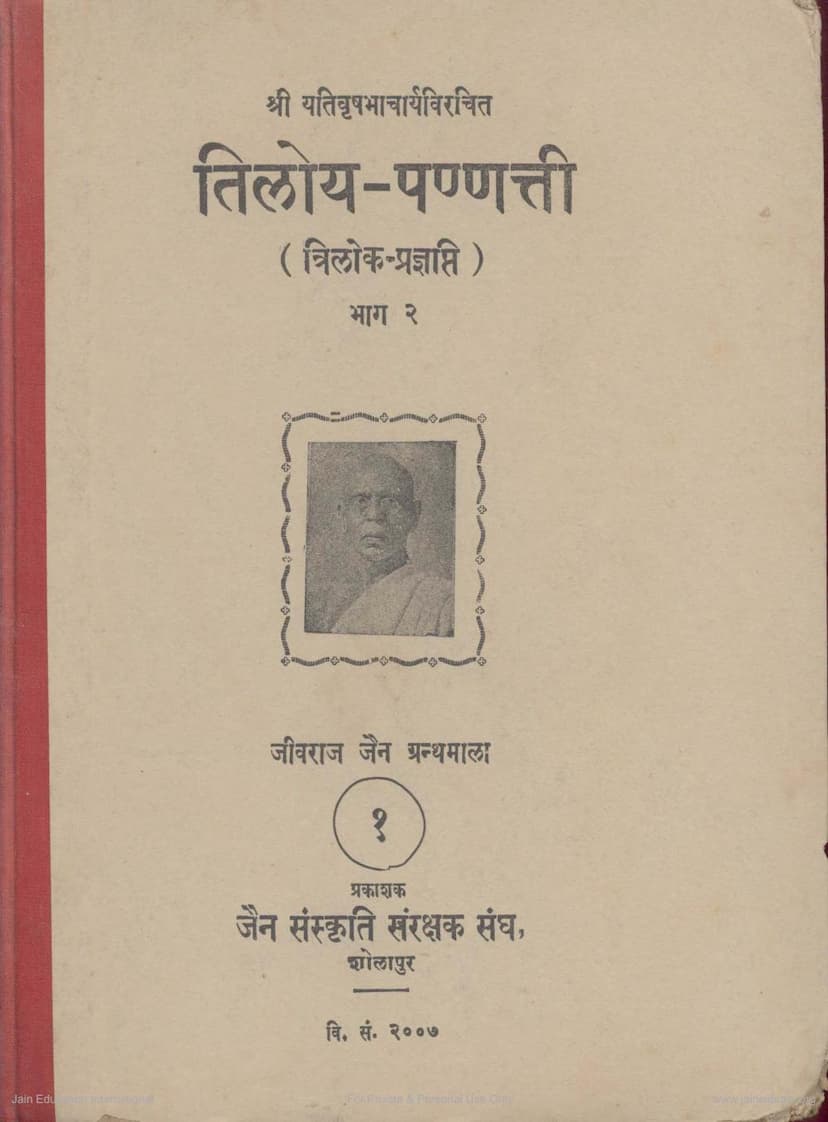Tiloy Pannati Part 2
Added to library: September 2, 2025

Summary
Here's a comprehensive summary of the Jain text "Tiloy Pannati Part 2," based on the provided text:
Book Title: Tiloy Pannati (Triloka Prajnapti) - Part 2 Author(s): Yativṛṣabha, Edited by Vrushabhacharya, A. N. Upadhye, Hiralal Jain Publisher: Jain Sanskṛti Samrakshak Sangh, Sholapur Publication Year: 1951 (Part II)
Overview:
"Tiloy Pannati" (Triloka Prajnapti), meaning "Declaration of the Three Worlds," is an ancient Prakrit text of Jainism, primarily focused on Jain cosmology, but also encompassing dogmatics, rituals, and historical aspects of Jain tradition. Part 2, as presented, is a continuation and completion of this monumental work.
Key Aspects and Summary:
1. Structure and Content:
- The text is primarily in Prakrit, with a significant portion in verse (gāthā) and some prose passages.
- The entire work is divided into nine Mahādhikāras (major sections), as enumerated by the author:
- General Nature of the Universe
- Hellish Regions (Nāraloka)
- Regions of Dwelling Deities (Bhavanavāśī Regions)
- Human World (Manushyaloka)
- Sub-human World (Tiryaṅgaloka)
- Regions of Intermediate Deities (Vyantara Regions)
- Luminaries (Jyotiṣka Regions)
- Heavenly Regions (Deva Regions)
- Realm of Liberation (Siddha Regions)
- Each Mahādhikāra is further subdivided into Adhikaras (sections) and sometimes even further into sub-sections.
- The text often uses numerical representations to describe cosmic elements.
- The editors note several drawbacks in the manuscript tradition, including corrupt readings, missing lines, and numerical errors, but assert the overall authenticity within the limits of the available material.
2. The Author: Yativṛṣabha:
- The authorship is attributed to Yativṛṣabha. The text itself provides clues, hinting at his name through a śleṣa (pun) in verses.
- External evidence from Indranandi's Srutāvatāra and the Jayadhavala commentary supports Yativṛṣabha's authorship and his connection to works like Cūrṇisūtras.
- His mastery of earlier texts like Āgrāyaṇī, Parikarmā, and Lokaviniscaya is evident, and he franky admits when traditional knowledge was unavailable or lost.
3. Yativṛṣabha's Date:
- The dating of Yativṛṣabha and the Tiloyapannatti is complex, with evidence suggesting a period between 473 AD and 609 AD.
- He is placed after authors like Kundakunda and Sarvanandi (458 AD) and before Virasena (816 AD) and Jinabhadra Kṣamāśramaṇa (609 AD).
- The historical details within the text, particularly the chronology of ruling dynasties after Mahāvīra's Nirvana up to Kalki (around 473 AD), suggest he flourished after this period.
4. Key Aspects of the Content:
- Cosmography (Karaṇānuyoga): A significant portion details the structure of the universe, including the dimensions of the various realms, lokapālas, and celestial bodies. This material aligns with other Jain cosmological works like Surya Prajnapti, Candra Prajnapti, and Jambudvīpa Prajnapti.
- Dogmatics: The text covers fundamental Jain principles, the nature of souls, karma, and the path to liberation.
- History and Chronology: It provides post-Mahāvīra Jain chronology, including the succession of Kevalins and Śruta-Kevalins, and mentions historical kings and dynasties, offering valuable insights into ancient Indian history.
- Salākapuruṣa: The lives and timelines of the Shālakāpuruṣas (great men) are detailed, which are also found in Puranic literature and biographies by authors like Hemachandra.
- Mangaḷa: The text begins with salutations to the Pañca Parameṣṭhins, with a specific order of mention (Siddha first, then Arhat). Salutations are also offered to Tirthankaras at the beginning and end of Mahādhikāras, showing a specific authorial intent.
- Comparative Study: The editors highlight the text's connections with other ancient Jain works like Mūlācāra, Pañcāstikāya, Pravacanaśāra, Samayasāra, Bhagavatī Ārādhanā, and the Sanskrit Lokavibhāga, noting shared verses and concepts.
- Geographical and Astronomical Details: The text provides descriptions of various regions, mountains, rivers, and astronomical calculations relevant to the Jain worldview.
- Jain Ideology: The concluding Mahādhikāra discusses Siddhas, methods of self-reflection, and core Jain tenets.
5. Editions and Publishers:
- The publication of Part II in 1951 by Jaina Samskṛti Samraksaka Samgha, Sholapur, under the Jīvarāja Jaina Granthamālā series, is noted.
- The editors, Drs. A. N. Upadhye and H. L. Jain, provided authentic editing with various readings.
- A Hindi paraphrase by Pt. Balchandra Siddhāntashāstri is also included.
6. Significance:
"Tiloyapannatti" is a foundational text for understanding Jain cosmology and its rich dogmatic and cultural material. Its comprehensive descriptions of the universe, its detailed astronomical and geographical accounts, and its historical references make it an invaluable source for scholars of Jainism and ancient Indian studies. The efforts of the editors and publishers in bringing this authentic text to light are highly appreciated, paving the way for further research and study.
In essence, "Tiloy Pannati Part 2" is a critical edition of a crucial ancient Jain text that meticulously details the Jain understanding of the cosmos, its inhabitants, and the principles governing them, presented with scholarly rigor and valuable comparative analysis.